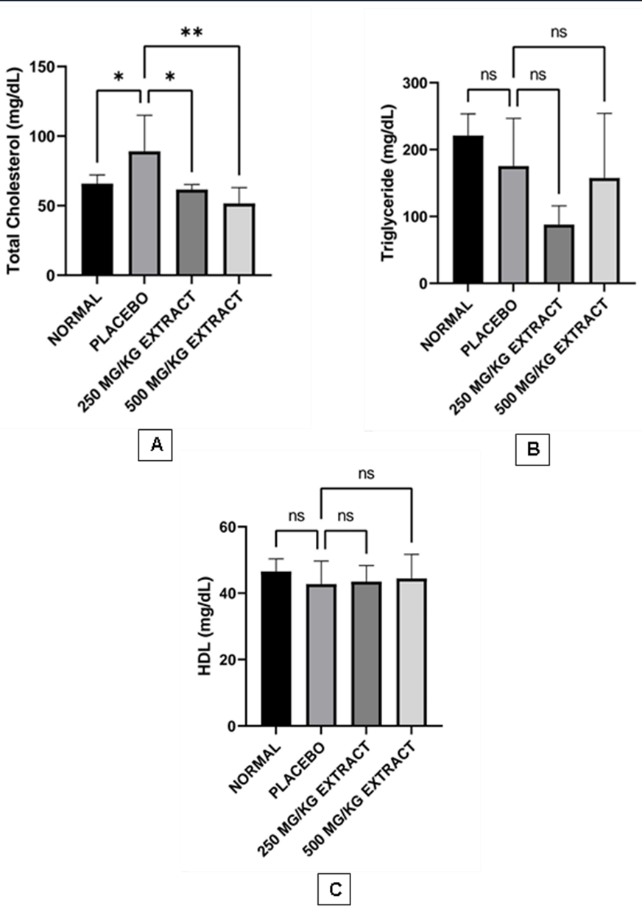1. Al-Zahrani J, Shubair MM, Al-Ghamdi S, Alrasheed AA, Alduraywish AA, Alreshidi FS, et al. The prevalence of hypercholesterolemia and associated risk factors in Al-Kharj population, Saudi Arabia: a cross-sectional survey. BMC Cardiovasc Disord. 2021;21(1):22. [
DOI:10.1186/s12872-020-01825-2] [
PMID] [
]
2. Vijayan J, Sruthy S, Neethu J, Manohar N, Babitha M, Soumya R. Hipercholesterolemia. European Journal of Biomedical and Pharmaceutical Sciences. 2018;5(9):115-23.
3. Vázquez-Cárdenas NA. Hipercolesterolemia primaria
Hipercolesterolemia familiar. Cardiovascular and Metabolic Science. 2021;32(S3):153-6. [
DOI:10.35366/100787]
4. Ibrahim MA, Asuka E, Jialal I. Hypercholesterolemia. StatPearls. Treasure Island (FL) ineligible companies. Disclosure: Edinen Asuka declares no relevant financial relationships with ineligible companies. Disclosure: Ishwarlal Jialal declares no relevant financial relationships with ineligible companies.2024.
5. Mal GS, Smakhtina AM. Secondary hyperlipidemia: definition, phenotypes, and inducing factors. International Heart and Vascular Disease Journal. 2021;9(32 (eng)):34-40.
6. Aa A, Hm H, Am E, Mohammed Ga K, Mohammed Aa L, Tb H, et al. Hypolipidemic Effect of Cinnamon (Cinnamomum zeylanicum) Bark Ethanolic Extract on Triton X-100 induced Hyperlipidemia in Albino Rats. Medicinal & Aromatic Plants. 2020;9(3). [
DOI:10.35248/2167-0412.20.9.351]
7. Hitl M, Gavarić N, Kladar N, Radovanović K, Srđenović B, Božin B. Phytotherapy in patients with cardiovascular diseases - A descriptive survey in Vojvodina, Serbia. Journal of Herbal Medicine. 2023;41. [
DOI:10.1016/j.hermed.2023.100684]
8. Djabir YY, Arsyad MA, Sartini S, Lallo S. Potential Roles of Kleinhovia hospita L. Leaf Extract in Reducing Doxorubicin Acute Hepatic, Cardiac and Renal Toxicities in Rats. Pharmacognosy Res. 2017;9(2):168-73.
9. Arung ET, Kusuma IW, Kim Y-U, Shimizu K, Kondo R. Antioxidative compounds from leaves of Tahongai (Klienhovia hospita). Journal of Wood Science. 2011;58(1):77-80. [
DOI:10.1007/s10086-011-1217-7]
10. Djabir YY, Arsyad A, Murdifin M, Tayeb R, Amir MN, Kamaruddin FA-F, et al. Kleinhovia hospita extract alleviates experimental hepatic and renal toxicities induced by a combination of antituberculosis drugs. Journal of Herbmed Pharmacology. 2020;10(1):102-8. [
DOI:10.34172/jhp.2021.10]
11. Rahim A, Saito Y, Miyake K, Goto M, Chen CH, Alam G, et al. Kleinhospitine E and Cycloartane Triterpenoids from Kleinhovia hospita. J Nat Prod. 2018;81(7):1619-27. [
DOI:10.1021/acs.jnatprod.8b00211] [
PMID] [
]
12. Ji X, Shi S, Liu B, Shan M, Tang D, Zhang W, et al. Bioactive compounds from herbal medicines to manage dyslipidemia. Biomed Pharmacother. 2019;118:109338. [
DOI:10.1016/j.biopha.2019.109338] [
PMID]
13. Balboa EZB, Hernandez IM, Ilagan ASD, Mae D. The Antihyperlipidemic Property of the Crude Methanolic Extract of Antigonon Leptopus Hook & Arn.(Polygonaceae) Leaves in Triton X-Induced Hyperlipidemic Male Sprague-Dawley Rats. European Journal of Molecular & Clinical Medicine. 2020;7(02):2020.
14. Arung ET, Kusuma IW, Purwatiningsih S, Roh SS, Yang CH, Jeon S, et al. Antioxidant activity and cytotoxicity of the traditional Indonesian medicine Tahongai (Kleinhovia hospita L.) extract. J Acupunct Meridian Stud. 2009;2(4):306-8. [
DOI:10.1016/S2005-2901(09)60073-X] [
PMID]
15. Alani FW, Djabir Y, Aryadi Arsyad M. Kleinhovia Hospita Leaf Extract Protects the Heart Against Infarction by Isoproterenol. Iranian Journal of Toxicology. 2023;17(2):87-94. [
DOI:10.32598/IJT.17.2.854.4]
16. Onwe P, Folawiyo M, Anyigor-Ogah C, Umahi G, Okorocha A, Afoke A. Hyperlipidemia: etiology and possible control. IOSR Journal of Dental and Medical Sciences. 2015;14(10):93-100.
17. Parwin A, Najmi AK, Ismail MV, Kaundal M, Akhtar M. Protective effects of alendronate in Triton X-100-induced hyperlipidemia in rats. Turk J Gastroenterol. 2019;30(6):557-64. [
DOI:10.5152/tjg.2019.18076] [
PMID] [
]
18. Hidayat A, Sulisetyawati TIB, Januarisca BV. Paliasa (Kleinhovia hospita L.) As An Immunomodulator: A Scooping Review. Malaysian Journal of Medicine & Health Sciences. 2023;19:183-6.
19. Aliyah EW, Kaelan C, Sila M. Preference Level Of Bees Apis Mellifera L. To The Supplementary Feed Of Mixed Syrup And Paliasa Leaf Decoction And Physico-Chemical Characteristics Of Produced Honey. International Journal of Scientific & Technology Research. 2013;2:4-8.
20. Amir M, Usman U. Isolation of Secondary Metabolite Compounds and Antibacterial Activities Tests From Hexane Extract of Stem Bark Melochia umbellate (Houtt) Stapf var. degrabrata K. Proceedings of the 2017 International Conference on Education and Technology (2017 ICEduTech): Atlantis Press; 2018. p. 95-9.
21. Chahlia N. Evaluation of Hypolipidaemic Activity of Capparis decidua. Int J Biomed Sci. 2009;5(1):70-3. [
DOI:10.59566/IJBS.2009.5070] [
PMID] [
]
22. Gazwi HSS, Hassan MS, Ismail HA, El-Naem GFA, Tony SK. The Hypoglycemic and Hypolipidemic Effects of Polyphenol-Rich Strawberry Juice on Diabetic Rats. Plant Foods Hum Nutr. 2023;78(3):512-9. [
DOI:10.1007/s11130-023-01079-1] [
PMID] [
]
23. Jawaida T, Khatoona S, Kamal M. Antihyperlipidemic effect of the aqueous extract from Cinnamomum tamala leaf in hyperlipidemic rats. Journal of Pharmacy Research. 2014;8(8):1098-104.











































